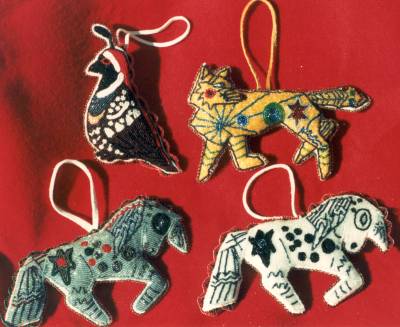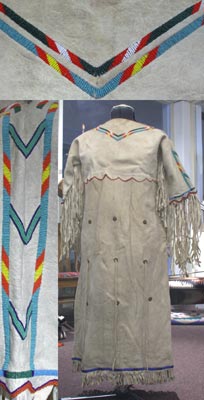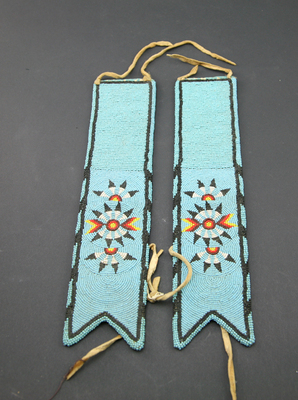Introduction
Bead working traditions can be found in almost every tribe located throughout North America. Because this art form was so widespread bead work created by the different tribes will show the traditions, designs, styles, and cultural significance of those tribes. The best-known Indian beadwork is created by the Plains Indians.
The Plains Indians are able to incorporate intricate beading and stitches into their artwork. The beadwork traditions can be found in the tribes located in the East, West, north, and Southwestern Indian tribes. The Eastern tribes used it primarily to decorate their wampum belts. The Western tribes created strands of beads for trade.
The Northern tribes used bead work to decorate their clothing and possessions with floral designs while the southwestern tribe incorporator turquoise beads into their designs. Because this art form was created by the majority of the tribes the beads were a common trade item. Due to the trade between the tribes and individuals from Europe it is possible to see beads created on one side of the country incorporated into the design of a tribe located on the opposite side of the country.
The bead work of the tribes experienced consistent evolutions as new items were incorporated into the designs. This evolution allowed the designs and materials from one tribe to influence the designs of a different tribe.
This paper will examine the history of Native American tribes and the increased use of bead work as a form of decoration. In order to narrow the scope of this paper the writer will be examining the symbolism found in the bead work produced by the tribes that were relocated to the Great Plains. By focusing on these tribes the symbolism will have some similarities due to the cultures of the tribes intermingling when they were relocated to the Great Plains. However it is expected that the symbolism of these tribes will still exhibit the influence of their own cultural heritage.
Forms of Art Created
The art created by the tribes living on the plains of America varied depending on the tribe creating the art. The art that was produced used various materials and was created for various purposes. There art incorporated wood, buffalo hides, grasses, beads and feathers. The majority of the art was created for use as personal decorations and belongings. In a spiritual sense the art was also an attempt to place the protection of the wearers guardian spirit onto the clothing and personal possessions of the individual and in turn to place that protection on the wearer. The belief that guardian spirits could be invoked for their protective powers or increased knowledge was a common spiritual practice of the Native American tribes. Because of this practice, the work can be used analyzed to trace the spiritual and cultural influences of the tribes.
The tribes were able to incorporate the use of color by combinations of minerals and vegetable dyes. When they had access to trading parties they began to use commercially produced dyes for the ease and increased amount of colors then were traditional available to them. The use of color was of such an important aspect of the cultural and spiritual significance to the Indians of the Plains that this paper will explore these cultural significances in greater detail later in this paper.
When examining the designs of the art work the viewer sees a range of designs ranging from the realistic to the abstract and symbolic. The art was used as a method of expressing both the history of the tribe as well as personal histories detailing the events that occurred in an individual’s life time.
History of Beads
Beads have been found in some form in every modern civilization over the past 40,000 years. Beads can be made of a variety of substances. They can be created with materials that are as simple as woven grass or as complex as gemstones. Due to the variety of substances that can be used to create beads every society since the advent of modern men has had the technological capacity of creating them (Monture, p. 3).
Because beads are so easy to create and incorporate into a societies culture it is an important to research the societies located in one geographic area for the general usage of the beads in cultural perspectives and then to research one culture in more detail to determine if the effects of the new cultural influences as exhibited by the artwork.
Traditional Native American Beads
When Native Americans first created beads for their art work they used items taken from their environment. Items that were commonly used included shells, coral, turquoise, copper and even animal teeth. These items were used to create bead jewelry, decorate personal belongings such as clothes and decorations for their homes (Monture, p. 4).
While beadwork was an important part of Native American culture from the beginnings of their culture, many individuals descended from those tribes are still creating beadwork for cultural and economic purposes. When examining the use of beads in art work across the cultures of the tribe’s native to America, turquoise has been found across the region (Monture, p. 5).
Glass Beads
Glass beads were created in Europe and transported to America by traders and settlers. While they were created throughout Europe the beads that provided the deepest colors in the greatest numbers was Venice Italy. The glass bead trade was controlled by families who closely monitored the recipes for the glass to prevent their competition from gaining an advantage in the market. Each time the beads were made the recipe was slightly alerted due the slight differences added or subtracted due to human error. This made it very difficult to match beads created at different times and match them exactly.
The beads were created through the traditional glass making procedures. The glass makers would create the molten glass by following one of the many recipes. Once the glass mixture had been created a small amount would be taken and a large air bubble would be inserted into glass by a metal blowing tube. Once the bubble had been created a separate individual placed an additional metal tube on the opposite end of the glass and the two individuals would stretch it out. Once the glass had been stretched to the proper thickness the glass was cut into smaller pieces and the beads were formed.
Glass beads were a popular trade item used by Europeans when they interacted with Native American tribes. When they were introduced to the various Native American tribes they were considered to be gifts from the gods because there was nothing that the Native Americans could compare them to. The reverence in which they were held can be seen through the naming conventions. In many of the languages, they were named after words for translucent objects and materials that were considered to be gifts of the gods through their cultural traditions.
Colors
When considering the use of colors in the various beadwork there are two theories. The first theory indicates that the use of color has an exclusive and symbolic meaning. In the Sioux tradition, the symbolism in the use of color can be tied to the four main elements as well as the cardinal directions (Bryne, 53). The color red is symbolically linked to the element of earth and the East. The element of air is linked to shades of blue and green. Yellow is symbolic of fire and the South and water and the North is linked to the color white. Black while not associated with one of the four elements is linked to the West (Bryne, p. 53).
The Crow tribes incorporated different symbolism. The color red was associated with several items. These items were property, blood and the desire for revenge. The color black was used to signify clouds or revenge that had been accomplished. This color was not often used (Bryne, p. 53). Green was used to symbolically represent the earth. While white was considered to represent fog, hail or the belief of innocence.
When considering the Cherokee culture, additional symbolism is found. Similarly to the Sioux, the Cherokee culture associated the use of color with the cardinal directions of North, South, East, and West. However in this culture the color red was associated with the direction of East (Bryne, 54). In a point of similarity between the Sioux and the Cherokee the colors representing the south, west and north have the same color association.
The other theory indicates that the use of color was subjective to the artist. When looking at the use of color reflecting the personal ideology of the artist additional correlations can be made. If an individual received a vision or went on a spirit quest the colors used could have a specific symbolism that is not associated with the colors cultural symbolism (Bryne, p. 53).
Symbolism of the Color in Bead Work
When examining beads occasional differences are found between the normal symbolisms associated with the color and its use in the bead work. One of these situations is the use of black. The traditional use of the color black is associated with various directions. This color is not often seen in the bead work; instead the color blue is used to replace it. It is believed that this was done in order to avoid the cultural association that black had with things that were not known or the mysterious (Bryne, p. 55).
An additional difficulty in understanding the cultural significance of the colors used in beadwork is the dislocation that many of the tribes experienced during the 19th century. The glass beads did not become widely available to the various tribes until the middle of the 19th century. By that point the many of the tribes had been relocated to new locations and forced to associate with tribes and cultures that were not in their traditional culture patterns (Bryne, p. 55).
Great Plains
The Great Plains are a harsh environment to live in. Due to the harsh physical conditions such as the risk of floods, hot and dry summers and the potential for terrible winters very few tribes called this area their home before America was settled by individuals from Europe (Fowler, p. 56). When the tribes began to be displaced by the European settlers the tribes with nomadic traditions migrated to the Great Plains. The culture allowed them to survive in these harsh conditions through various migratory patterns. The tribes that were displaced to the Great Plains include the Blackfeet, Comanche, Pawnee, Sioux, Cheyenne and Crow (Fowler, p. 56). Part of the adaption of these tribes was the incorporation of the buffalo on their culture.
The buffalo became the main source of clothing, shelter and food for the majority of the tribes living in this location. The women were responsible for transforming the buffalo hide into various forms as well as for their decorations. The women would create outfits and decorations from the diverse material available to them including feathers and claws.
The decorations of the clothing contained symbolism relating to the hierarchy of the tribe as well as religious symbolism. Through the use of the beaded and painted garments the tribes were able to connect with the spiritual forces that unified the tribes (Phillips, p. 113). The tribes were also known to have created paintings on the hides of buffalo as well as artwork created through the use of quills, needlework and clothing design unique to the specific tribes (Phillips, p. 113).
Bead Work from the Great Plains Tribes
The tribes from the Great Plain area have a long history of decorating their clothing and possessions with a combination of paint and beadwork (Fowler, p. 144).
The below image is a group of decorative items with examples of the bead work typically produced by tribes of the Great Plains. Tribes located on the Great Plains were required to keep their decorative arts light and easy to transport. The below items would have been used to decorate the living areas of members of the tribe and represent animals with a great significance for the tribe. This group has the image of two horses. The horse was vital to the success of the tribes living on the plains. The buffalo that was the source of their existence were migratory animals making it mandatory that the tribe be able to move their camps when the buffalo were migrating.

Crow Indian Tribe
The Crow tribe was separated into three geographical areas at the beginning of the 19th century. They had the reputation of being among one of the friendliest native tribes to the European settlers and the American people. This encouraged an increase of trade between the Crow and the American’s resulting in the Crow being among the wealthiest tribes located in this area. Chad large houses or lodges, highly decorated clothing, and many horses that were used to transport their goods as well as hunt buffalo.
The women were adept at using natural objects, paint, and beads to decorate the personal possessions of the tribe (Fowler, p. 71). These skills resulted in their goods being valued as trade items because of the intricate decorations that adorned those objects.
Bead Work from the Crow Indian Tribe
Traditionally the bead work produced by individuals from the Crow tribe was used to create decorative items such as clothing and coverings for the arms and legs. The image below is one of decorated arm bands.
The use of the light blue background was done in order to assure the artist that their design would be visible from a distance. It is possible that the light blue background is a representation of the sky. The design in the middle of the work is a symbol of consistency among the tribes living on the Great Plains (Fowler, p. 89). These symbols combined with the band around the edges which is known as a sky band could indicate that the work was created for use in a religious ceremony. The ceremony could have been to ask the spirits of the sky for greater consistency of fair weather.
Figure 3 of the Appendix an image of a traditional Crow dress that would have been similar to the clothing worn during the 19th centaury. The beadwork that adorns this outfit has been increased to allow the reader to see the different layers of beadwork and the entire design.

The material of the dress is buffalo hide. This was the basis of the majority of the clothing created by the tribe for either personal use or for trade purposes. The combination of bead work around the neck of the garment could be a reflection of the personal preference of the artist and an indication of ownership (Fowler, 62). The use of red beads by the Crow was very rare due to the added expense of the beads combined with the cultural negative connotations.

Conclusion
This paper examined the use of beads commonly found in Native American art. By examining the history of the beads it was possible for the reader to understand the value that the Native American tribes considered to be located in there bead work. The writer chose to focus on the symbolism presented in the bead work of tribes located on the Great Plains with particular attention given to the Crow tribe. It was expected that there would be some similarities in the symbolism due to the intermingling of the various tribe’s cultures during the relocation to the Great Plains. The writer believed that the symbolism of the tribes located on the Great Plain would demonstrate the intermingling as well as aspects of their own cultural heritage.
The tribes located on the Great Plains used color to provide symbolic meaning for the individuals who displayed the artwork as decorations of there homes or decorations on their clothes. The intermingling of cultures can be seen while examining the symbolic meaning of the primary colors used.
In several tribes the colors blue and green are used to symbolically represent the sky. The color white was used to symbolically represent the direction of north. While only two colors were used by various tribes to represent similar concepts the fact that they did exist shows that by living together on the Great Plains resulting in the increased interaction of the tribe’s ideas and beliefs of several tribes were mingled. This also shows that even through the tribes cultures were mingling there was a concentrated effort to ensure that the tribe’s cultural identities remained as intact as possible.
References
- Byrne, James. A Beginner’s Handbook to Traditional Native American Beadwork. Bloomington, Indiana, 2005.
- Fowler, Loretta. The Columbia Guide to American Indians of the Great Plains. Columbia University Press. New York. 2003.
- Montour, Joel. Traditional Native American Beadwork. Columbia University Press. New York. 1999.
- Phillips, Ruth B. Native North American Art. Oxford History of Art. 009.
- Wildscrut, William and Ewers, John C. Crow Indian Bead Work: A Descriptive and Historical Perspective. 2009. Web.